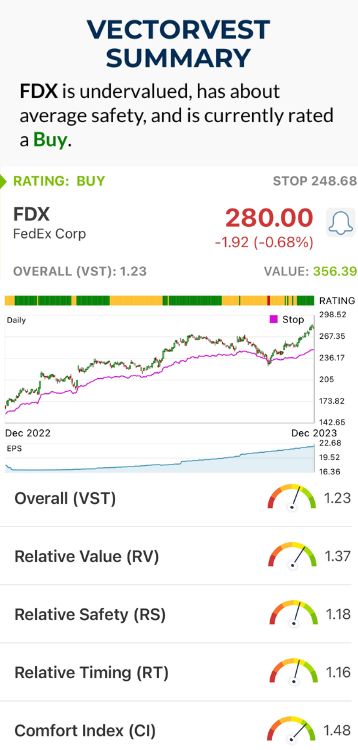In a crushing quarter 2 report released yesterday, FedEx (FDX) cut its full-year revenue to $22.2 billion in 2024 from $22.8 billion in 2023. The report caused FedEx to fall 9.8% in the stocks, ruining months of gains. Despite the market’s adverse reaction, nobody can blame a company for cutting costs during high interest rates, and investors are still willing to rally behind the historically significant company.
Besides revenue, FedEx’s earnings per share (EPS) also took a hit, lowering to $253.31 in premarket trading after reporting second-quarter earnings per share of $3.99, which missed expectations of $4.19. While maintaining full-year earnings guidance at $17.75 per share, the company projected a decline in sales, contrary to the previous forecast of flat sales in fiscal 2024. The stock’s drop threatened to erase gains of 62% that FedEx made throughout the year.
What’s causing the shift? CEO Raj Subramaniam provided some color regarding the report, “We are moving with speed to make our network more efficient while delivering outstanding service to our customers through the peak season with the fastest Ground network in the industry. I am confident in our strategy as we make our global network more flexible, efficient, and intelligent.” The commentary was accompanied by a 2024 outlook for “Permanent cost reductions from the DRIVE transformation program of $1.8 billion.” Both statements combined can be summarized into cost-cutting efforts and company restructuring, which positively contributed to an improved operating profit margin of 6.4%.
What’s the good news for FedEx? What goes down will come back up in a ripping market, and a company valued at $62.66 billion dollars with a historically positive performance has a positive outlook, especially while FDX makes moves to maintain historical levels of profitability through cost cutting. Considering the size and overall health of the company, investors are willing to get behind the turnaround plan that will restructure the company. The challenging quarter that the market immediately reacted to isn’t a foreshadowing of a significant plummet but rather a period for company structure changes for more profitability.
The difference for FDX is that it historically performs well; however, current events impacted the potential for soaring revenues in Q2. VectorVest uses software to push aside those current events and view the company for all of its components for the future. The software uses data and financial metrics to determine if FDX is worth the investment.
Don’t Get Tripped Up On FedEx’s Fall
The market’s immediate and often emotional reaction to reports can skew the outlook for a company. A legitimate financial analysis considers several components, not just 1 earnings report. VectorVest software generates three summary ratings: relative value (RV), relative safety (RS), and relative timing (RT), each scored from 0.00 to 2.00, with 1.00 representing the average; then the overall VST (Value-Safety-Timing) rating provides a decisive buy, sell, or hold suggestion for a specific stock. VectorVest’s three summary and overall ratings evaluated FDX and concluded with a BUY recommendation.
- Very Good Upside Potential: The Relative Value score for FDX is 1.37, making it decently above average on a scale of 0.00 to 2.00. It is undervalued, with a current price of $280.00 but a value of $356.39 because of the potential for the company to continue climbing the market.
- Good Safety: FDX has a Relative Safety score of 1.18, which is above average on a scale of 0.00 to 2.00, related to its large market cap and ability to recover during financially stressful times.
- Good Relative Timing: The relative timing of FDX is 1.16, rated as good on a scale of 0.00 to 2.00. The metric considers the stock movements daily, weekly, quarterly, and yearly, so even with the poor earnings report, the overall timing of FedEx is favorable considering all timelines and comparisons for the company.
The overall VST rating of FDX is 1.23, which is considered above average and is followed by a BUY recommendation in the VectorVest system. BUY indicates that if you own the stock, you should keep it in your portfolio and consider getting more, and if you’re not already invested, definitely buy in.
Although the initial reaction to FDX’s decline in revenue seems off-putting for investors, VectorVest shows the company's performance as an overview. You can see the trajectory and risks associated with the company through the Very Good Upside Potential. You can learn more about how the system works or the current opportunity with any given stock through a free stock analysis today!
Want These Types of Insights at Your Fingertips so You Can Win More Trades?
Use VectorVest to analyze any stock free. VectorVest is the only stock analysis tool and portfolio management system that analyzes, ranks and graphs over 18,000 stocks each day for value, safety, and timing and gives a clear buy, sell or hold rating on every stock, every day.
VectorVest advocates buying stocks with proper analysis, not just the market’s movements for that day. FedEx fell 9.8% due to its disappointing earnings report, but VectorVest helped investors visualize its financial health. The stock has very good upside potential, good safety, and good relative timing, with a recommendation to BUY. Allowing you to see all the necessary components to make an informed decision.
Before you invest, check VectorVest! Click here to ANALYZE ANY STOCK FREE and see our system in action!












Leave A Comment